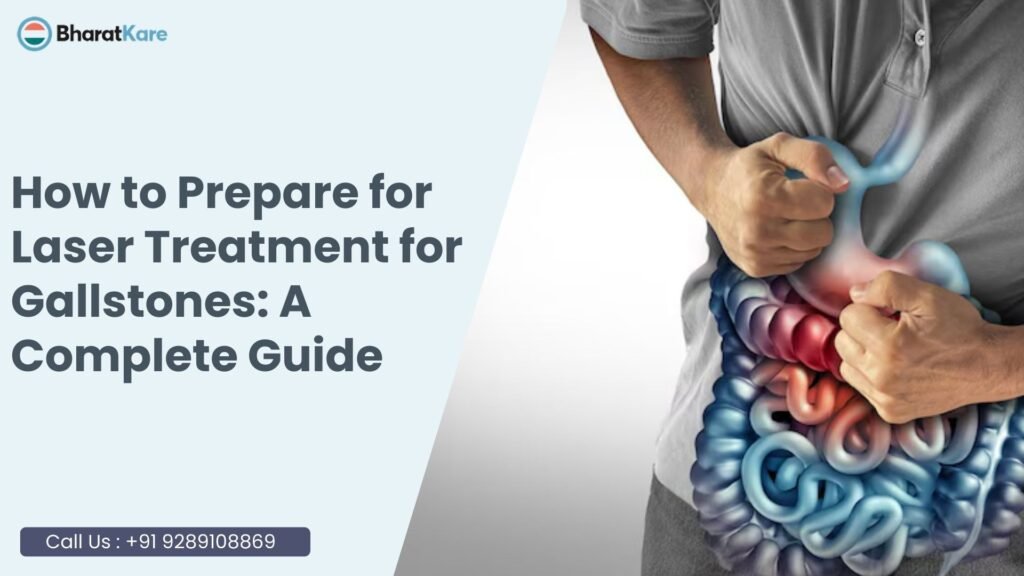How to Prepare for Laser Treatment for Gallstones: A Complete Guide
How to Prepare for laparoscopic for Gallstones: A Complete Guide Gallstones are a common health issue, especially among women, and can cause significant discomfort if left untreated. While there are various treatment options available, laparoscopic for gallstones has emerged as a modern, minimally invasive, and effective solution. If you’re considering this advanced procedure, it’s essential to understand how to prepare for it properly. This guide will walk you through everything you need to know about gallstones treatment, focusing on laparoscopic for gallstones, and how Bharatkare can help you through the process. Gallstones can be an incredibly painful and disruptive condition, often causing sharp, cramping pain in the upper abdomen, nausea, vomiting, and even jaundice if left untreated. For many, the discomfort can become so severe that it interferes with daily life, making it difficult to eat, sleep, or even move comfortably. Traditional treatment options, such as gallbladder removal surgery, can be daunting due to their invasive nature and longer recovery times. However, laparoscopic for gallstones offers a modern, minimally invasive alternative that targets the problem directly, breaking down gallstones with precision and allowing patients to recover quickly and return to their normal routines. At Bharatkare, we specialize in this advanced procedure, combining cutting-edge technology with expert care to provide a safe, effective, and comfortable solution for those suffering from gallstones. If you’re tired of living with the pain and inconvenience of gallstones, laparoscopic for gallstones could be the life-changing solution you’ve been looking for. Call Us : +91 9289108869 What Are Gallstones? Gallstones are hardened deposits of digestive fluid that form in the gallbladder, a small organ located beneath the liver. They can vary in size, from as small as a grain of sand to as large as a golf ball. Common gallstones symptoms in females include severe abdominal pain, nausea, vomiting, and bloating. If you experience these symptoms, it’s crucial to consult a healthcare professional for an accurate diagnosis and appropriate gallstones treatment. Gallstones are primarily of two types: cholesterol stones and pigment stones. Cholesterol stones, which are the most common, form when there’s too much cholesterol in the bile. Pigment stones, on the other hand, develop when there’s an excess of bilirubin, a chemical produced during the breakdown of red blood cells. Factors such as obesity, a high-fat diet, rapid weight loss, and certain medical conditions like diabetes can increase the risk of developing gallstones. Why Choose Laparoscopic for Gallstones? Laparoscopic for gallstones is a cutting-edge procedure that uses focused laser energy to break down gallstones into smaller fragments, making them easier to pass or remove. This method is less invasive than traditional surgery, reduces recovery time, and minimizes the risk of complications. Unlike traditional surgical methods, such as cholecystectomy (removal of the gallbladder), laparoscopic for gallstones preserves the gallbladder while effectively addressing the problem. This is particularly beneficial for patients who prefer to avoid surgery or who have medical conditions that make surgery risky. The precision of the laser ensures that only the gallstones are targeted, leaving surrounding tissues unharmed. How to Prepare for Laparoscopic for Gallstones Proper preparation is key to ensuring a successful laparoscopic for gallstones. Here’s a step-by-step guide to help you get ready: 1. Consultation and Diagnosis Before undergoing laparoscopic for gallstones, you’ll need a thorough consultation with a healthcare provider. During this visit, your doctor will review your medical history, perform a physical examination, and order diagnostic tests such as an ultrasound or CT scan to confirm the presence of gallstones. It’s important to be open and honest during this consultation. Share any symptoms you’ve been experiencing, even if they seem unrelated. This helps your doctor make an accurate diagnosis and determine whether laparoscopic for gallstones is the best option for you. If you have any concerns or questions about the procedure, this is the time to ask. 2. Discuss Your Medical History Be sure to inform your doctor about any existing medical conditions, allergies, or medications you’re taking. This information is crucial for determining whether laparoscopic for gallstones is the right option for you. Certain conditions, such as bleeding disorders or heart problems, may require additional precautions. Similarly, medications like blood thinners or anti-inflammatory drugs may need to be temporarily stopped before the procedure. Your doctor will provide specific guidance based on your individual health profile. 3. Follow Pre-Procedure Instructions Your doctor will provide specific instructions to follow in the days leading up to the procedure. These may include: Fasting for a certain period before the treatment. Avoiding certain medications, such as blood thinners, to reduce the risk of bleeding. Staying hydrated and maintaining a healthy diet. Fasting is typically required for at least 6-8 hours before the procedure to ensure your stomach is empty. This reduces the risk of complications during anesthesia. Staying hydrated in the days leading up to the treatment is also important, as it helps your body prepare for the procedure and aids in recovery. 4. Arrange for Transportation Since laparoscopic for gallstones is typically performed under sedation or anesthesia, you’ll need someone to drive you home after the procedure. Make sure to arrange this in advance. It’s a good idea to have a friend or family member stay with you for the first 24 hours after the procedure, as you may feel groggy or tired from the anesthesia. Having someone around can provide peace of mind and ensure you have everything you need during the initial recovery phase. 5. Prepare for Recovery While laparoscopic for gallstones is minimally invasive, you may still need some time to recover. Plan to take a few days off work and avoid strenuous activities during this period. Prepare your home for recovery by setting up a comfortable resting area with easy access to essentials like water, medications, and entertainment. Stock up on light, easy-to-digest foods such as soups, broths, and crackers. Having these items ready will make your recovery smoother and more comfortable. What to Expect During the Procedure Understanding what happens during laparoscopic for gallstones can help ease any anxiety


